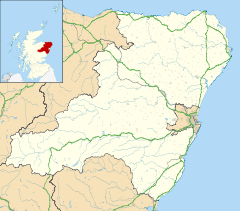Arbuthnott (Scottish Gaelic: Obar Bhuadhnait, "mouth of the Buadhnat")[1] is a hamlet and parish in the Howe of the Mearns, a low-lying agricultural district of Aberdeenshire, Scotland. It is located on the B967, east of Fordoun (on the A90) and north-west of Inverbervie (on the A92).[2] The nearest railway station is Laurencekirk.
Arbuthnott
| |
|---|---|
| Village | |
 Arbuthnott Parish Church | |
Location within Aberdeenshire | |
| OS grid reference | NO8024975550 |
| Council area | |
| Country | Scotland |
| Sovereign state | United Kingdom |
| Post town | LAURENCEKIRK |
| Postcode district | AB30 |
| Dialling code | 01561 01569 |
| Police | Scotland |
| Fire | Scottish |
| Ambulance | Scottish |
| UK Parliament | |
| Scottish Parliament | |

The most salient feature of the hamlet is the 13th century Parish Church of St Ternan,[3] in which the Missal of Arbuthnott was written. Today the church is part of the combined parish of Arbuthnott, Bervie and Kinneff.[4]
Lewis Grassic Gibbon, an author remembered for his novels about life in the Mearns, grew up at Bloomfield in the parish of Arbuthnott.[5] A small museum in the hamlet is dedicated to him, named the Lewis Grassic Gibbon Centre. This is built as an extension to the village hall, and contains an exhibition about the author and his work. The centre also contains a café, and post office facilities.
Arbuthnott House, the seat of the Viscount of Arbuthnott, is near the hamlet.
Prehistory and archaeology
editIn 2004, CFA Archaeology conducted archaeological investigations next to the hamlet in advance of the construction of the Aberdeen to Lochside natural gas pipeline. There they discovered the remains of four Middle Bronze Age roundhouses, one Iron Age post-built roundhouse with a souterrain entered from the house, and two medieval/post-medieval corn-drying kilns. It is thought that more houses might exist but they were outside the area that would be impacted by the pipeline and so were not excavated.[6]
Arbuthnott House
editThe existing house incorporates sections of a 13th/14th century castle built by the Arbuthnott family, and was greatly expanded in the 15th century when a courtyard was created at its base. A range was built on the side of the courtyard in the 16th century. In the 1750s the entrance was adjusted and the overall composition remodelled to create a symmetrical arrangement. A fine plaster ceiling of 1685 is one of the more important internal features.[7]
Notable people
edit- John Arbuthnot (1667–1735), often known simply as Dr Arbuthnot, Scottish physician, satirist and polymath
- The Most Rev. George Gleig (1753-1840), Primus of the Scottish Episcopal Church[8]
- The Very Rev. Samuel Trail (1806–1887), minister of the parish 1841–44 and Moderator of the General Assembly in 1874
Listed buildings
editWithin the community of Arbuthnott, there are a number of listed buildings and structures:
- Arbuthnott House - category A
- Arbuthnott House - Doocot - category C(s)
- Arbuthnott House - East Gate - category B
- Arbuthnott House - Garden House - category B
- Arbuthnott House - Ice House - category B
- Arbuthnott House Mains Farm - category B
- Arbuthnott House Sundial - category B
- Arbuthnott House, North Bridge over Arbuthnott Burn - category A
- Arbuthnott Parish Kirk - category A
- Former Arbuthnott Church Manse (Kilternan) - Category C[1]
More broadly, within the former parish boundaries, there are a futherer four buildings and structures which have listed status:
- Allardyce Castle - Category A
- Allardyce Castle - Gate Piers - Category A
- House of Kairs - Category B
- House of Kairs Main Farmhouse - Category B
Source: [9]
See also
editNotes
edit- ^ a b Mac an Tàilleir, Iain (2003). "Ainmean-Àite" (PDF). The Scottish Parliament. p. 5. Retrieved 26 October 2022.
- ^ Beach, Russell, ed. (1978). AA Touring Guide to Scotland. The Automobile Association. ISBN 978-0-86145-093-0.
- ^ "History of the Howe - Arbuthnott". Mearns Community Web. Retrieved 28 April 2007.
- ^ "About". ABK Church. Retrieved 26 October 2022.
- ^ "Mitchell, (James) Leslie [pseud. Lewis Grassic Gibbon]". Oxford Dictionary of National Biography (online ed.). Oxford University Press. doi:10.1093/ref:odnb/38328. (Subscription or UK public library membership required.)
- ^ Johnson, Melanie (2017). "Excavation of prehistoric roundhouses and post-medieval kilns at Drumyocher and Hospital Shields, Aberdeenshire". Scottish Archaeological Internet Reports. 70. Society of Antiquaries of Scotland. doi:10.9750/issn.2056-7421.2017.70.
- ^ The Castles of Scotland by Adam Swan ISBN 1-899874-00-3
- ^ "Gleig, George". Oxford Dictionary of National Biography (online ed.). Oxford University Press. doi:10.1093/ref:odnb/10810. (Subscription or UK public library membership required.)
- ^ "Listed Buildings in Mearns Ward, Aberdeenshire". British Listed Buildings. Retrieved 26 October 2022.
External links
edit


